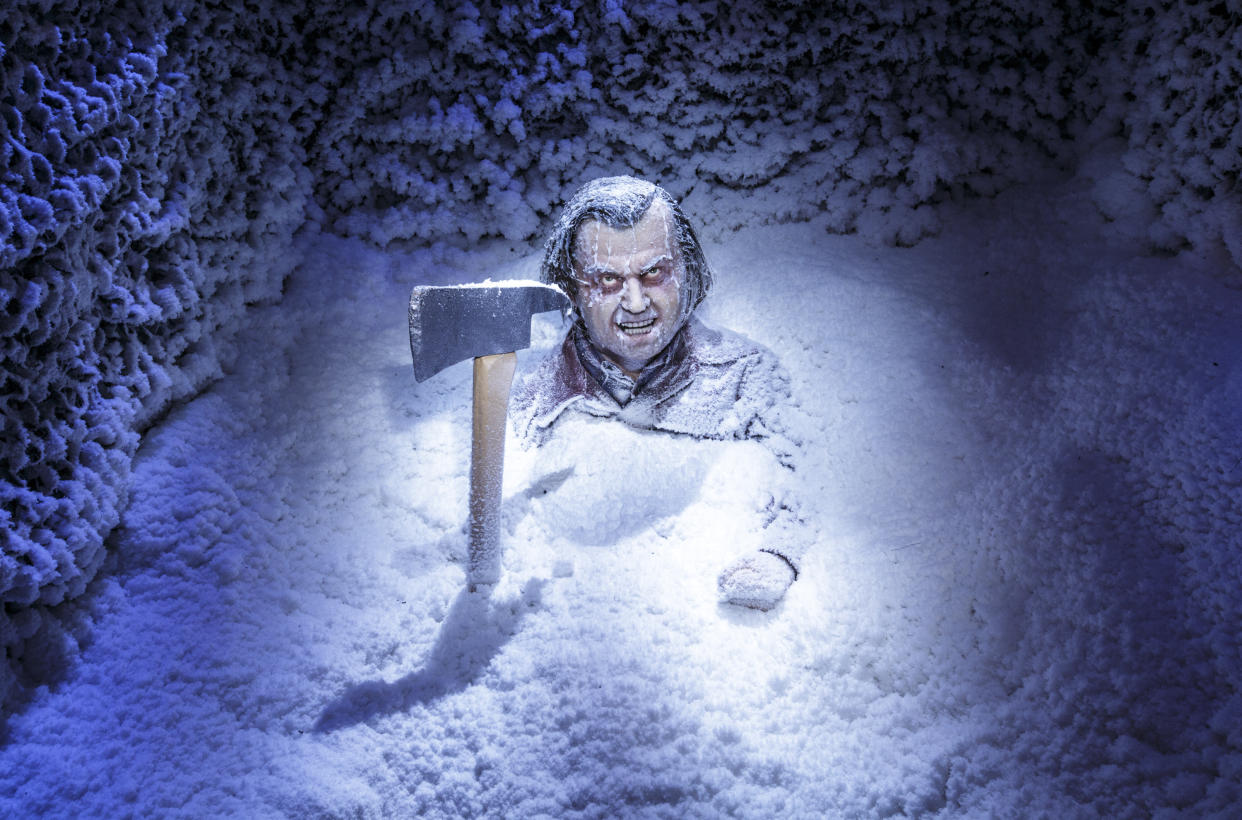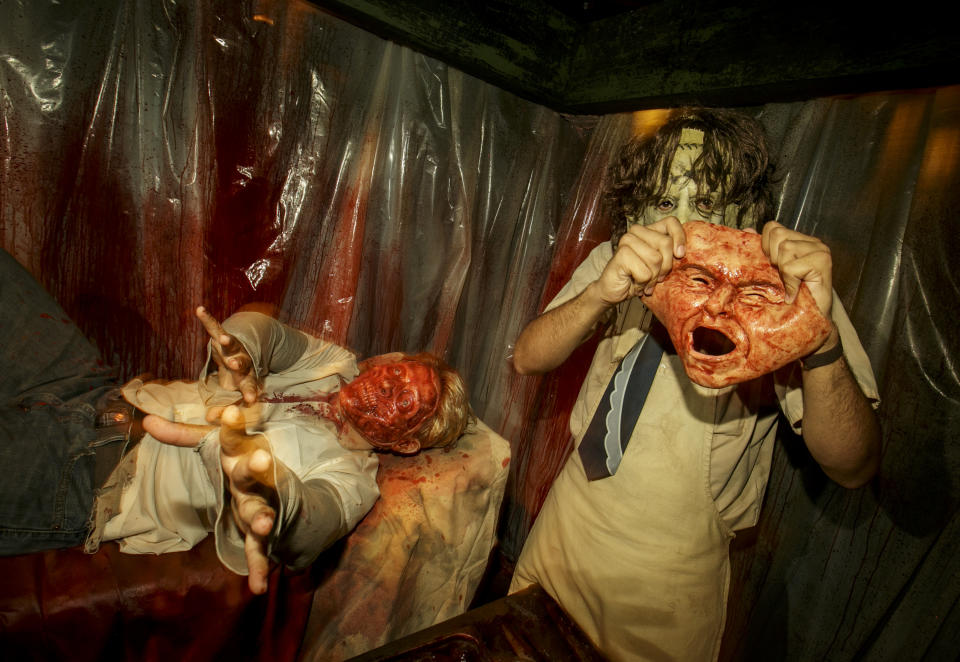It's alive! How Hollywood transforms scary movies into scary experiences

Ah, Halloween. That time of year when we crave a good jump scare, and the only thing better than watching a horror movie is living a horror movie. In recent years in Hollywood, transforming a movie into a visceral experience has been a sport. Acclaimed fright impresarios like Jason Blum, Guillermo del Toro, and John Landis have worked with top designers to create attractions based on their movies, both at theme parks — Universal Studios Hollywood’s Halloween Horror Nights is the gold standard — and as stand-alone locations. This year has seen the scares ratcheted up, with the pop-up It-based Neibolt House on Hollywood Boulevard (later relocated to the Warner Bros. lot) and Fox’s Horror Rewind, a downtown Los Angeles installation based on four of the studio’s freakiest flicks. Yahoo Entertainment went behind the scenes with the (literal) puppet masters of these attractions to find out their secrets to scaring us silly.
Here’s Johnny!
Universal Studios Hollywood has morphed its amusement park into a seasonal scare-fest since 1991, adding more elaborate horror-movie “mazes” each year. The 2017 edition includes another King-based classic adaptation, The Shining. The park’s creative director, John Murdy, has helped establish the standard for creating immersive cinematic experiences for attendees, and he took us through his process.
Watch a time-lapse video of construction on Halloween Horror Nights:
“I’ve seen the movie multiple times, but when we realized we were going to be able to do The Shining, I sat down with my notebook and started writing, and it took me eight hours to go through that movie. We don’t watch horror movies like normal people. We’re constantly looking at every single aspect of it and what can be translated to a live event. Murdy listens for musical cues and sound effects. He combs through fan blogs and message boards to find out what scenes resonate with viewers. “Then we just start making lists. List every environment that factors into The Shining. Then list all the characters … the special effects. And then we’ll literally take Post-it notes and start putting them up on the walls of my office and then piece together into a Post-it note version of the maze.”
From there, Murdy writes a treatment, about 100 pages per maze, that is both “a narrative written from the guest point of view … and a very elaborate technical breakdown of all the elements we need: props, costumes, wardrobe, makeup, audio, lighting.”
Once that’s all set, they construct the maze, making sure to match the feel of the movie, which is often easier said than done. “We reproduced that sign for the Overlook hedge maze. We even created the carpet. The same carpet that’s in the movie, we custom-created it; we designed it ourselves in the computer and digitally printed it onto carpet so that it could be exactly like the carpet in the movie, which doesn’t exist anymore. You can’t go back to the studio and go, ‘Hey! Remember that movie you made in 1980? Do you guys have that carpet?’ None of it exists.”
Watch a walk-through of the Shining experience:
He also makes sure to put in lots of Easter eggs for the obsessive fans: “There’s a key fob for Room 237 that’s stuck in the door that I guarantee you most people don’t even notice. But the fans looking down at the door, they’ll see that exact one that was exactly like the one in the film. …
“What it came down to was staying true to Stanley Kubrick’s vision, particularly his visuals, and in some cases flat-out resist the temptation to have a guy jumping out and scaring you in every scene. We have whole scenes that don’t have a single character in them. There’s nobody in the bathroom, in 237; there’s nobody in the elevator, the blood elevator; there’s nobody in the scene with the Grady twins when they appear and disappear in the hallway. That’s because that doesn’t happen in the movies. We had to find a way to pay off Stanley’s visual iconography and be true to that and still make it scary for people who are coming to a haunted attraction — that was the real challenge.”
With Universal being a theme park, it has to make sure that each horror attraction — and its cast of performers — can withstand the foot traffic. “The ‘Here’s Johnny!’ scene has some complicated physical things. We have to play out that scene so every fan who goes through can see it and they all get that moment, but also make sure it’s repeatable for the performers that are doing it. … They’re going to do that about 60,000 times. They’ll perform that scene at least 60,000 times.”

In addition to The Shining, Universal has film-based attractions based on Jason Blum’s horrific oeuvre, including Saw, Insidious, and The Purge; a Titans of Terror maze stocked with characters from A Nightmare on Elm Street, Friday the 13th, and The Texas Chain Saw Massacre; and a ghouled-up version of the studio’s tram tour starring Chucky.
You’ll float too.
The cursed town of Derry, Maine, was temporarily relocated in Los Angeles this fall, as the 29 Neibolt Street spook house from Stephen King’s It was erected at the landmark corner of Hollywood and Vine in advance of the movie. Director Andy Muschietti took a hands-on approach to designing the experience, whose lines extended down the Walk of Fame. “I wanted to capture the feel of the movie,” Muschietti told us, noting that he worked closely to design the rooms to replicate key scenes from his film using a combination of actors, atmospheric set design, and animatronic monsters.
Watch the writer tour the It house:
Muschietti and the studio worked with Grand Design, which bills itself as an experiential marketing company, to create the house, which represents the movie’s greatest hits. “Each room you went into was a scene from the film: You have the clown funeral, the slideshow, the bathroom, the sewer pipe,” explains Gary Soloff, director of marketing for the Warner Bros. studio tour. “The idea was really to create buzz around the film and create a walk-through experience on Hollywood Boulevard, open to everyone for free.”
But, thanks to city officials, it couldn’t be as scary as Muschietti intended. “It needs to be dark; things need to jump out and scare you,” he explained. “For public safety, we had to turn more lights on.”
After its limited run in Hollywood, the Neibolt House was packed up and shipped over the hill to the Warner Bros. lot, where it was incorporated into the studio’s Horror Made Here experience, which puts a frightful spin on the studio’s popular tour. A portion of the backlot was redressed to look like Derry from the movie, with neighboring areas set up like the high school from A Nightmare on Elm Street and a collection of houses riffing on The Conjuring. “We have the relic room … we have the witch, the Crooked Man, the nun — it’s really creepy,” says Soloff. “I’ve been through it, like, six times but I still get scared.”
Watch a time-lapse video of Horror Made Here:
Be afraid. Be very afraid.
While Warners conceived its Neibolt House as part of a marketing campaign for the motion picture, Fox created Horror Rewind to promote its rerelease of classic horror titles on Blu-ray. The studio commissioned artist Orlando Arocena to create new artwork for the films and then collaborated with the Great Company, a creative studio specializing in “experiential content,” and the interactive theater company Delusion, known for its Halloween expertise, for an immersive installation bringing to life four of the titles: 28 Days Later… , The Hills Have Eyes, The Fly, and Carrie.

Once the brain trust settled on the titles, they selected key moments from each film to bring to life, including Carrie’s classic bloody prom scene. For them, like Murdy, there was one key to getting the adaptation right. “It was a lot of writing, to be honest, and the writing continued changing up until [opening] night,” says Carl Choi of the Great Company, one of the event’s producers.
Watch a time-lapse video of construction on Horror Rewind:
“It’s storytelling, right?” he said. “And in storytelling, you want that story arc. So when you walk into this space, the audience is actually part of the story. So we want to make sure that there’s some sort of closure, and often it’s hard to do that in an interactive show like this. But we just had to figure it out. So honestly, it’s a lot of trials. Us walking through ourselves, seeing what works and what doesn’t, seeing if there are screams from new people coming through, and really just observing all the details. But yeah, it was definitely a lot of writing.”
Who knew scaring was such hard work?
Our picks for the most bonkers horror-movie twist endings of all time:
Read more from Yahoo Entertainment:

